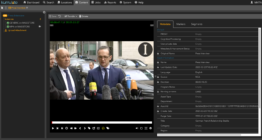Column: Even in the cloud, content is never at rest

Subscribe to NewscastStudio for the latest news, project case studies and product announcements in broadcast technology, creative design and engineering delivered to your inbox.
So, you’ve decided to incorporate cloud storage into your environment…
Now comes the hard part – figuring out which content will be stored in the cloud, whether it will be stored anywhere else, and how that content will be migrated to the cloud.
It can sometimes feel as if every time you make one decision, you just expose another subset of decisions that need to be made. Using a third party can provide a shortcut to obtaining the necessary expertise and streamlining the process. But how do you decide which vendor is right for the job?
There are many organizations that are moving data from legacy on-premise systems to the cloud today, and as a consequence, there are many vendors and tools that tout their ability to handle data migrations. However, if the files that you are migrating are predominantly media files such as video clips, sequences and projects, it’s worth considering a few important factors – format, metadata, and interoperability.
Almost every media organization has legacy media files in a range of different formats. Whether these assets are all digitized, or whether some will be digitized as part of the migration, dealing with the various media formats, wrappers, and file types should be part of your migration strategy.
Since all the files need to be accessed during the migration, transcoding and/or rewrapping them only adds a small amount of overhead to the process. If you are looking to standardize on a common archive format, add mezzanine formats, or incorporate a proxy workflow for your archived assets, this could be a perfect opportunity to implement those changes.
While standardizing your media format and adding instances in other formats can make it easier for different systems to use your files, it won’t help users and applications find the right content. Particularly with legacy media files, lack of descriptive metadata can make it difficult or impossible to discover assets.
Incorporating artificial intelligence and machine learning services into the migration process can quickly and effectively add this metadata in a way that would have previously required manual logging by a team of subject matter experts – a luxury that few organizations could afford.
Regardless of whether you choose to leverage enrichment services or not, any existing or new metadata should be retained and stored in a non-proprietary way that makes it accessible to any other systems that may need to work with your assets today in the future. If your choice of migration provider comes at the expense of closed systems and adding workflow complexity, it may be time to reconsider your decision.
For many organizations, cloud storage is supplementary to their existing on-premise storage. Whether you are planning to continue using on-premise storage in the long term with cloud storage holding secondary copies of your assets for business continuity, or you are opting for a more gradual transition from on-premise to cloud storage, it is critical to have a content storage system that can manage the asset copies across a hybrid storage environment and provide a single namespace for the users and applications that need to access the assets.
Even if you are planning to completely replace your on-premise storage, using a system with hybrid support will ensure that your systems have uninterrupted access to assets during the migration process and help to optimize the physical resources needed to read from the legacy storage.
Alongside the media-specific concerns related to these projects, there are some more generic concerns that broadly applicable to any type of migration. Probably the most important of these is how to best control and monitor the costs of both the migration and the long-term storage itself. Migration vendors that are storage-agnostic can provide you with an unbiased opinion regarding the advantages of different lifecycle policies and storage tiering solutions.
For all of these reasons, it’s important to choose a vendor with deep experience in managing the movement and migration of content. Whether you are making a bulk move to the cloud, taking a more gradual approach, or adopting a hybrid storage ecosystem, your migration partner can help you navigate complex decisions so that your end state is one that meets all your current needs and gives you the flexibility to adapt in the future as your needs change.
Subscribe to NewscastStudio for the latest news, project case studies and product announcements in broadcast technology, creative design and engineering delivered to your inbox.





tags
artificial intelligence, cloud, Cloud Broadcast Production, Cloud Storage, hybrid, Masstech, media storage, Metadata, Savva Mueller
categories
Broadcast Engineering News, Content, Content Delivery and Storage, Featured, Media Asset Management, Voices